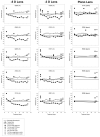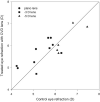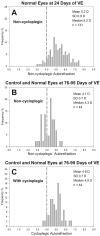Effectiveness of hyperopic defocus, minimal defocus, or myopic defocus in competition with a myopiagenic stimulus in tree shrew eyes
- PMID: 17065475
- PMCID: PMC1979094
- DOI: 10.1167/iovs.05-1369
Effectiveness of hyperopic defocus, minimal defocus, or myopic defocus in competition with a myopiagenic stimulus in tree shrew eyes
Abstract
Purpose: To examine the ability of hyperopic defocus, minimal defocus, and myopic defocus to compete against a myopiagenic -5-D lens in juvenile tree shrew eyes.
Methods: Juvenile tree shrews (n > or = 5 per group), on a 14-hour lights-on/10-hour lights-off schedule, wore a monocular -5-D lens (a myopiagenic stimulus) over the right eye in their home cages for more than 23 hours per day for 11 days. For 45 minutes each day, the animals were restrained so that all visual stimuli were >1 m away. While viewing distance was controlled, the -5-D lens was removed and another lens was substituted with one of the following spherical powers: -5 D, -3 D (hyperopic defocus); plano (minimal defocus); or +3, +4, +5, +6, or +10 D (myopic defocus). Daily noncycloplegic autorefractor measures were made on most animals. After 11 days of treatment, cycloplegic refractive state and axial component dimensions were measured.
Results: Eyes with the substituted -5- or -3-D-lens developed significant myopia (mean +/- SEM, -4.7 +/- 0.3 and -3.1 +/- 0.1 D, respectively) and appropriate vitreous chamber elongation. All animals with the substituted plano lens (minimal defocus) during the 45-minute period showed no axial elongation or myopia (the plano lens competed effectively against the -5-D lens). Variable results were found among animals that wore a plus lens (myopic defocus). In 11 of 20 eyes, a +3-, +4-, or +5-D lens competed effectively against the -5-D lens (treated eye <1.5 D myopic relative to its fellow control eye). In the other eyes (9/20) myopic defocus was ineffective in blocking compensation; the treated eye became more than 2.5 D myopic relative to the control eye. The +6- and +10-D substituted lenses were ineffective in blocking compensation in all cases.
Conclusions: When viewing distance was limited to objects >1 m away, viewing through a plano lens for 45 minutes (minimal defocus) consistently prevented the development of axial elongation and myopia in response to a myopiagenic -5-D lens. Myopic defocus prevented compensation in some but not all animals. Thus, myopic defocus is encoded by at least some tree shrew retinas as being different from hyperopic defocus, and myopic defocus can sometimes counteract the myopiagenic effect of the -5-D lens (hyperopic defocus). However, it appears that minimal defocus is a more consistent, strong antidote to a myopiagenic stimulus in this mammal closely related to primates.
Figures







References
-
- Norton TT, McBrien NA. Normal development of refractive state and ocular component dimensions in the tree shrew (Tupaia belangeri) Vision Res. 1992;32:833–842. - PubMed
-
- Pickett-Seltner RL, Sivak JG, Paternak JJ. Experimentally induced myopia in chicks: morphometric and biochemical analysis during the first 14 days after hatching. Vision Res. 1988;28:323–328. - PubMed
-
- Smith EL, III, Hung LF. The role of optical defocus in regulating refractive development in infant monkeys. Vision Res. 1999;39:1415–1435. - PubMed
-
- Bradley DV, Fernandes A, Lynn M, Tigges M, Boothe RG. Emmetropization in the rhesus monkey (Macaca mulatta): birth to young adulthood. Invest Ophthalmol Vis Sci. 1999;40:214–229. - PubMed
-
- Cook RC, Glasscock RE. Refractive and ocular findings in the newborn. Am J Ophthalmol. 1951;34:1407–1413. - PubMed
Publication types
MeSH terms
Grants and funding
LinkOut - more resources
Full Text Sources

